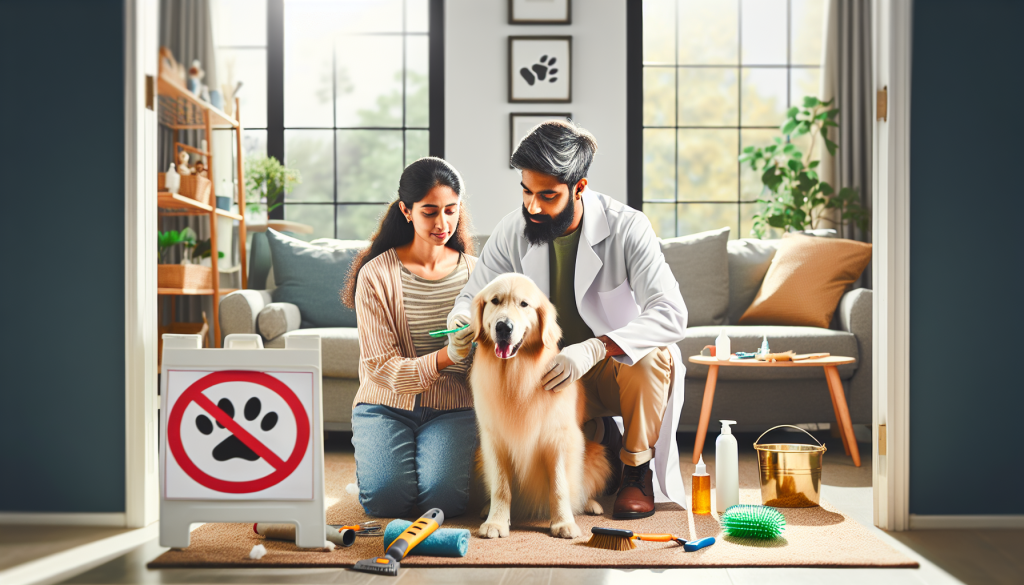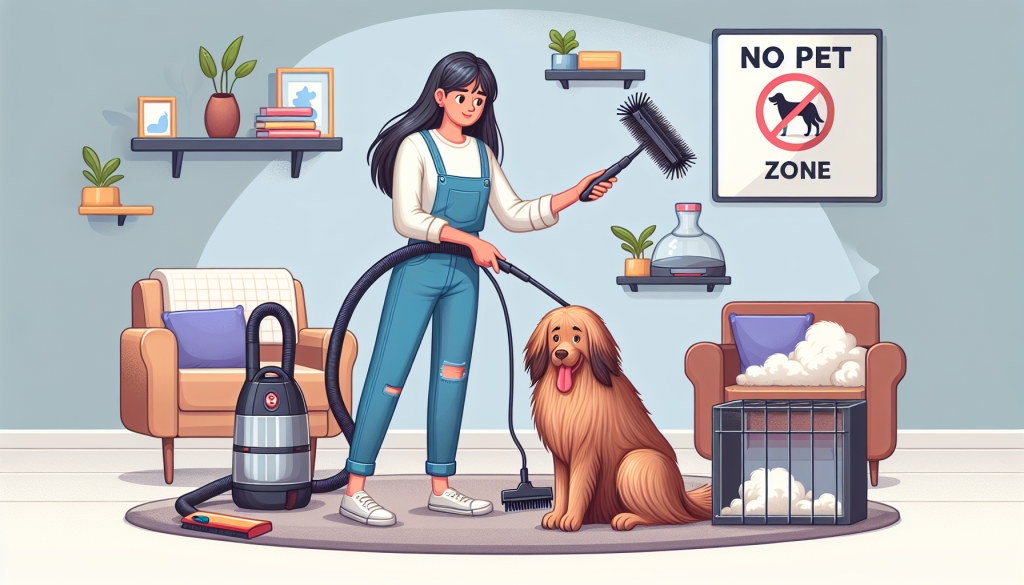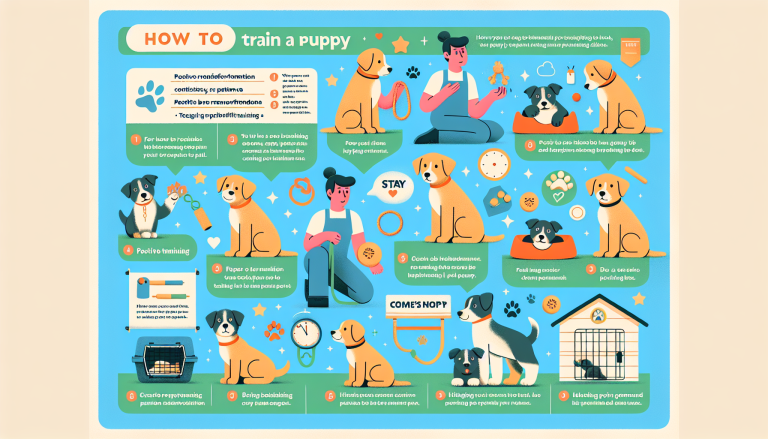Are you a proud pet owner but struggling with pet allergies? Look no further! This article is here to help you navigate through the challenges of dealing with pet allergies. Whether you are allergic to cats, dogs, or any other furry friend, we have got you covered. We will provide you with practical tips and strategies to help minimize the effects of pet allergies, allowing you to enjoy a harmonious and allergen-free environment with your beloved pet. Say goodbye to sneezing and itching, and say hello to a happier, healthier pet-owner relationship!
Table of Contents
TogglePreventing Pet Allergies
Choosing Hypoallergenic Pets
When it comes to preventing pet allergies, one of the best places to start is by choosing a hypoallergenic pet. These are pets that are less likely to cause an allergic reaction because they produce fewer allergens. Some examples of hypoallergenic pets include certain dog breeds like poodles, bichon frises, and Portuguese water dogs. Additionally, some cat breeds, such as the Siberian cat and the Balinese cat, are considered hypoallergenic. By selecting a hypoallergenic pet, you can greatly reduce the risk of allergies for you and your family.
Maintaining a Clean Environment
Keeping a clean environment is essential in preventing pet allergies. Regularly cleaning and dusting surfaces can help to remove allergens that may have settled. Vacuuming is especially important, as it can effectively remove pet dander and fur from carpets and furniture. Additionally, using allergen-proof covers on pillows and mattresses can minimize exposure to allergens while you sleep. By maintaining a clean environment, you can create a healthier space for both you and your pet.
Creating Pet-Free Zones
Creating pet-free zones in your home can be another effective way to prevent pet allergies. You can designate certain areas where your pet is not allowed, such as bedrooms or living rooms. This can help to minimize your exposure to allergens in areas where you spend a significant amount of time. By creating pet-free zones, you can enjoy the companionship of your pet while still having allergy-free spaces to retreat to when needed.
Reducing Allergens in the Home
Regular Cleaning and Vacuuming
Regular cleaning and vacuuming play a crucial role in reducing allergens in your home. Dusting surfaces, sweeping floors, and wiping down furniture can help to remove allergens that your pet may have left behind. If possible, use a vacuum cleaner with a HEPA filter, as it can effectively capture small allergen particles. By incorporating regular cleaning and vacuuming into your routine, you can significantly minimize the presence of allergens in your home.
Using Air Purifiers
Air purifiers can be a valuable tool in reducing allergens in your home. These devices work by filtering the air and trapping particles, such as pet dander and pollen, that can trigger allergies. Be sure to choose an air purifier with a HEPA filter, as it is specifically designed to capture small particles. Place the air purifier in rooms where you and your pet spend the most time to maximize its effectiveness. Using an air purifier can help create a cleaner and healthier environment for you and your pet.
Washing Pet Bedding Regularly
Regularly washing your pet’s bedding is an essential part of reducing allergens in your home. Pet bedding can become a breeding ground for allergens, such as pet dander and pollen, if left unwashed. Wash your pet’s bedding at least once a week using hot water and a hypoallergenic detergent to effectively remove allergens. Additionally, consider using a dryer on a hot setting to further eliminate any remaining allergens. By keeping your pet’s bedding clean, you can significantly reduce the presence of allergens in your home.
Grooming and Bathing Tips
Grooming your Pet Frequently
Regular grooming is important in managing pet allergies. Brushing your pet’s fur frequently can help to remove loose hair and dander, reducing the amount of allergens in your home. Use a pet brush or comb that is specifically designed for your pet’s coat type to effectively remove excess hair and dander. Depending on your pet’s breed and coat length, you may need to groom them daily or several times a week. By incorporating grooming into your routine, you can proactively manage pet allergens.
Using Hypoallergenic Shampoos
Using hypoallergenic shampoos when bathing your pet can also help in preventing pet allergies. These shampoos are formulated to be gentle on your pet’s skin and minimize the release of allergens. Look for shampoos that are specifically labeled as hypoallergenic and free from harsh chemicals and fragrances. When bathing your pet, be sure to thoroughly rinse off the shampoo to remove any remaining allergens. Regular baths with hypoallergenic shampoos can contribute to a healthier and more allergy-friendly environment.
Brushing and Trimming Hair
In addition to regular grooming and bathing, brushing and trimming your pet’s hair can also help in managing pet allergies. Regular brushing helps to remove loose hair and dander, preventing them from becoming airborne allergens. Depending on your pet’s hair length and breed, you may need to brush them more frequently. Trimming your pet’s hair can also help to minimize shedding and reduce the amount of allergens in your home. By incorporating these practices into your pet’s grooming routine, you can effectively control pet allergens.
Managing Allergies with Medications
Over-the-Counter Antihistamines
Over-the-counter antihistamines can offer temporary relief from pet allergy symptoms. These medications work by blocking the action of histamines, which are released during an allergic reaction. Common over-the-counter antihistamines include cetirizine, loratadine, and fexofenadine. However, it is important to consult with a healthcare professional before taking any medication, as they can provide guidance on the appropriate dosage and potential side effects.
Prescription Medications
For more severe pet allergies, prescription medications may be necessary. These medications, such as nasal corticosteroids or leukotriene modifiers, can help to alleviate allergy symptoms by reducing inflammation and blocking the release of allergens. It is important to consult with a healthcare professional or allergist to determine the most suitable prescription medication for your specific allergy needs.
Allergy Shots
Allergy shots, also known as allergen immunotherapy, can be a long-term treatment option for managing pet allergies. This treatment involves receiving regular injections of small amounts of allergens to gradually desensitize the immune system. Over time, the immune system becomes less reactive to allergens, reducing allergy symptoms. Allergy shots are typically administered under the guidance of an allergist and can provide long-term relief for pet allergies.
Natural Remedies for Pet Allergies
Saline Nasal Rinses
Saline nasal rinses can help to alleviate allergy symptoms by flushing out allergens from your nasal passages. This natural remedy involves using a saline solution, typically made of salt and water, to irrigate your nasal passages. This can help to reduce nasal congestion, sneezing, and itching caused by pet allergies. Saline nasal rinses can be purchased at pharmacies or made at home using a saline solution kit.
Steam Inhalation
Steam inhalation is another natural remedy that can provide relief from pet allergy symptoms. Inhaling steam helps to moisturize and soothe your nasal passages, reducing congestion and promoting easier breathing. Add a few drops of essential oils, such as eucalyptus or lavender, to further enhance its benefits. Be cautious when using steam inhalation, as hot steam can cause burns.
Quercetin Supplements
Quercetin is a naturally occurring compound found in certain fruits, vegetables, and herbs. It is believed to have anti-inflammatory and antihistamine properties, which can help to alleviate pet allergy symptoms. Quercetin supplements are available in pill or capsule form and can be taken daily to reduce allergy symptoms. However, it is important to consult with a healthcare professional before starting any supplement regimen.
Consulting with a Veterinarian
Getting Allergy Testing
If you suspect that you or your pet may have allergies, it is important to consult with a veterinarian. The veterinarian can perform allergy testing to identify the specific allergens causing the allergic reaction. This testing may involve blood tests or intradermal skin tests to determine the allergens and severity of the allergies. By understanding the specific allergens, you can take appropriate measures to manage and prevent allergies in the future.
Discussing Treatment Options
Once the allergens have been identified, it is crucial to discuss treatment options with your veterinarian. They can provide guidance on the most suitable treatment plan based on your pet’s specific allergies and health conditions. This may include medication options, dietary changes, or environmental modifications to reduce exposure to allergens. By working closely with your veterinarian, you can develop an effective treatment plan to manage pet allergies.
Managing Other Health Conditions
During the consultation with your veterinarian, it is important to discuss any other health conditions your pet may have. Certain health conditions, such as respiratory or skin infections, can exacerbate pet allergies. By addressing these underlying health conditions, you can help to alleviate allergy symptoms and improve your pet’s overall well-being. Your veterinarian can provide guidance on managing any concurrent health conditions along with pet allergies.
Preparing Allergy-Friendly Pet Food
Choosing Hypoallergenic Pet Food
For pets with food allergies, choosing hypoallergenic pet food is essential. Hypoallergenic pet food is formulated to minimize the risk of triggering an allergic reaction. These foods are typically made with novel protein sources, such as venison or duck, and limited ingredients to reduce the likelihood of allergens. Consult with your veterinarian to determine the most suitable hypoallergenic pet food for your pet’s specific dietary needs.
Avoiding Common Allergens
Common allergens in pet food include grains (such as wheat or corn), soy, and certain proteins (such as beef or chicken). Avoiding these common allergens can help in preventing allergic reactions. Look for pet food that is labeled as grain-free or limited ingredient, as they are less likely to contain these allergens. Additionally, consider feeding your pet single-source protein diets, such as fish or lamb, if they have known protein allergies.
Reading Labels Carefully
When selecting pet food, it is important to read labels carefully. Pay attention to the ingredients list and any potential allergens that may be present. Additionally, look for pet food that is certified by reputable organizations, ensuring that it meets specific quality and safety standards. Reading labels carefully can help you make informed decisions about the best allergy-friendly pet food options for your furry friend.
Teaching Proper Hygiene Habits
Washing Hands After Petting
Good hygiene habits can go a long way in preventing pet allergies. Encourage everyone in your household to wash their hands thoroughly after petting or playing with your pet. Washing hands with soap and water helps to remove allergens that may have transferred from your pet’s fur or saliva. By making handwashing a habit, you can significantly reduce the risk of allergens spreading throughout your home.
Avoiding Touching Face
Another important hygiene habit is to avoid touching your face after interacting with your pet. Touching your face, particularly your eyes, nose, and mouth, can transfer allergens and potentially trigger an allergic reaction. Encourage everyone in your household, especially children, to be mindful of this habit and refrain from touching their face after petting or playing with your pet.
Keeping Pet Supplies Clean
Regularly cleaning your pet’s supplies is crucial in maintaining a clean environment and preventing pet allergies. Wash their food and water bowls daily to remove any accumulated allergens or bacteria. Clean their toys, bedding, and litter box regularly using pet-friendly cleaning products. By keeping their supplies clean, you can minimize the risk of allergens and maintain a healthier environment for both you and your pet.
Recognizing Allergy Symptoms
Respiratory Symptoms
Pet allergies often manifest as respiratory symptoms in humans. These symptoms can include sneezing, coughing, wheezing, nasal congestion, and shortness of breath. If you experience these symptoms consistently when exposed to pets, it is likely that you have a pet allergy.
Skin Symptoms
Skin symptoms are also common with pet allergies. These symptoms may include itching, redness, hives, or a rash after coming into contact with pet dander or saliva.
Eye and Nose Symptoms
Allergy symptoms affecting the eyes and nose are prevalent with pet allergies. These symptoms can include watery or itchy eyes, redness, swelling, itching or tingling in the nose, and frequent sneezing when exposed to pets.
Considering Alternative Pets
Fish and Reptiles
If you or someone in your household has severe pet allergies, considering alternative pets like fish or reptiles may be a viable option. These pets do not produce dander or shed fur, making them a hypoallergenic choice. Fish tanks and reptile enclosures can still be great sources of companionship, with the added benefit of being allergy-friendly.
Small Animals and Birds
Small animals, such as hamsters, gerbils, or rabbits, are also suitable alternative pets for individuals with allergies. These pets typically have minimal dander and can be kept in designated areas to minimize allergen exposure. Birds, such as parakeets or canaries, can also make great pets for those with allergies, provided their cages are kept clean and allergen-free.
Robotic Pets
Robotic pets are becoming increasingly popular as alternatives for individuals with pet allergies. These lifelike pets offer companionship without the risk of triggering allergies. Robotic pets can provide a sense of comfort and joy without the worry of allergens present in traditional pets.
By following these tips and taking proactive measures, you can prevent pet allergies and create a harmonious environment for both you and your furry friend. Remember to consult with a healthcare professional or veterinarian to determine the best course of action for managing pet allergies based on your specific situation. With the right approach, you can continue to enjoy the love and companionship of your pet while maintaining good health.








